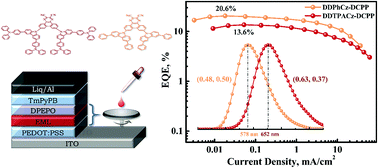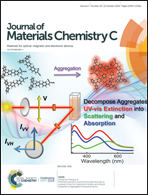Highly efficient electroluminescence from evaporation- and solution-processable orange–red thermally activated delayed fluorescence emitters†
Abstract
The development of orange–red thermally activated delayed fluorescence (TADF) emitters with good solution processability and excellent emissive characteristics for highly efficient solution-processable organic light-emitting diodes (OLEDs) still remains a big challenge. Here, two TADF molecules were designed and synthesized by introducing 2,3-dicyanopyrazino phenanthrene as the acceptor unit and carbazole derivatives as the donor unit. The thermal, photophysical, electrochemical, and electroluminescence (EL) properties of the two emitters were systematically investigated. Both emitters exhibit reasonably small single–triplet energy gap and relatively high photoluminescence quantum yield values. Solution-processable yellow OLEDs exhibited a maximum current efficiency, a power efficiency, and an external quantum efficiency (EQE) of 53.2 cd A−1, 45.6 lm W−1, and 20.6%, respectively. Vacuum-deposited devices employing the same emitter also showed high efficiencies of 54.8 cd A−1, 50.7 lm W−1, and 20.8%, with similar EL spectra to those of solution-processable OLEDs. The maximum EQE of solution-processable red devices was 13.6%, with Commission Internationale de L’Eclairage coordinates of (0.63, 0.37). These results are among the best values for long-wavelength TADF OLEDs, demonstrating that highly efficient solution-processable TADF OLEDs can be realized through effective material design and device optimization.



 Please wait while we load your content...
Please wait while we load your content...